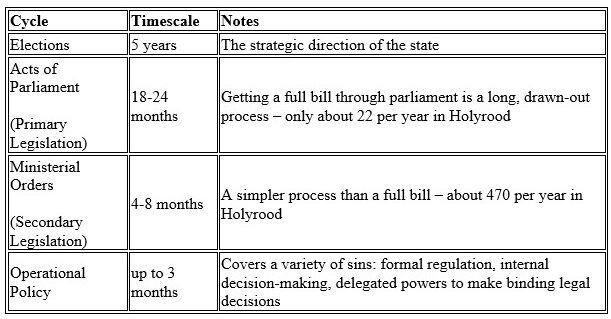Digital
Basic Law-Making For Legislative Computer Systems – Part 1
August 28, 2023 by Stewart Hamilton No Comments | Category Digital Scotland, Research
Blog by Scottish Government, Research Fellow, Gordon Guthrie.
Gordon is a Research Fellow at the Scottish Government under the First Minister’s Digital Fellowship Programme. All opinions in this blog are his own and they do not represent Scottish Government policy.
This is the first of five articles outlining the research of the Blus project – Basic Law-Making For Legislative Computer Systems.
Part 1 – We Need A Gearbox
We know that successful and high-quality services (both digital and non-digital) are built iteratively, by engaging with the user base and shaping and moulding their outputs on the basis of doing, reviewing, learning and adapting.
We know that the law and government is also an iterative process. Laws are passed, and retrospectively amended. Acts of parliament (primary legislation) grants Ministers powers to make and remake law by orders (secondary legislation) and civil servants the powers to write and rewrite ordinary regulations.
The most common complaint about the digital state is that the government moves too slowly for the pace of technological iteration – the gearbox problem. Two systems turning at different speeds must be brought into harmony.
If these two great engines were whirling independently, all would be well. The lawyers and policy wonks over there going at their speed, and the code monkeys and service designers over here dancing to their own drumbeat.
Sadly this is not so. State computer systems and services cannot and do not exist outside of, or beside the law. And in the final analysis the purpose of my research project BIus – Basic Lawmaking For Statutory Services is about designing a gearbox that links these two spinning juggernauts in such away that the one doesn’t tear the other apart.
Revolutions are only proper revolutions if their slogans are in French – so this project has three mantras: explicité, constitutionalité and simplicité.
Explicité says make processes explicit – the legal engine drives the systems and service engines, but often in ways that are neither named nor understood.
Constitutionalité is the principle that the law, and the apparatus of law, is the bride and technology and design and project management and all the rest are never more than the bridesmaid. The gearbox is fundamentally a constitutional and not a technical instrument. The technical processes we need must be molded to the constitution and not the other way round.
Simplicité relates more to the implementation – start with the simplest working, explicit and constitutional intervention and rely on the experts who work within the system to improve, expand, extend and enrich it. An implicit system is not able to be continuously improved – an explicit system is. The problems that the state faces in building digital systems are entanglement problems – and disentangling delivers benefits one tangle at a time. Simple steps, but lots and lots of them.
Most problems in the digital public sector have already been solved, by a bill team, by a policy team, by an operational or delivery team, perhaps in Scotland, perhaps elsewhere. Perhaps by your team. The task of this project is to collect and systematise all of them.
In Scotland the legislative engine has 4 gears:
The normal legislative cascade is one of restriction – the constitution restricts what lawmakers can do, but within that they have the broadest discretion. In Parliamentary Acts (primary legislation) they pass on restricted powers to ministers to make orders (secondary legislation) and grant even more restricted powers to civil servants to make and impose regulation by operational policy. (The minister may in turn devolve a fragment of their power down to civil servants by order).
But in crude terms, the way in which iteration is accelerated to technical speed at the moment is use of a framework bill. The slow Primary Legislation is used to grant extensive Secondary Powers to the Minister who when uses that power to make decisions at a medium pace – or pass powers onto civil servants to make decisions on fast.
The power to do things is granted by stripping away restrictions on doing things. There is a fundamental constitutional problem here. The solution to solving problems arising from the separation of powers is never to merge powers – as a general rule and principle the government should not be able to mark its own homework.
Digital technologies are tremendous concentrators – for good and for ill.
I stumbled on a cine club with a wee cinema on its knees thanks to Covid. Thanks the magic of Twitter a quarter of a million people now know about it, we have 3 short films in production. Heartwarming.
By contrast Gamergate – a tsunami of orchestrated and concentrated hate.
So it is with digital government – for the miracle of contact tracing under COVID, there is the horror of Chinese social media policy for Uighurs.
The combination of faster digital iteration, delegation of broad powers to ministers and civil servants and digital concentration makes a heady and toxic cocktail.
It is also a cocktail that we have seen drunk before in the UK – it is not a novelty – and I have written about the government taking huge executive powers before.
To design a government gearbox we have understand two things in great detail.
The first is speedbumps – things on the legislative side that slow down implementation – and the 2nd article in this series will talk about how we go about doing that.
The second thing is to build a detailed catalogue of the types of decisions that the technical trades need to make, everything from data, technical design, organisation design, UX and user experience – and the 3rd article will talk about how we do that.
When we have these two things we need to build a legislative architecture that shows us how to fit all these decisions together in the right way to achieve the maximum amount of iteration and delivery speed at the lowest cost. But speed is not alone, for each type of decision that each specialist team takes we need to think about how it is supervised and scrutinised by the parliament – or by bodies setup by the parliament (the Audit Commission model).
The rough shape of the legislative architecture will be the subject of the 4th article – and the 5th article will cover how we will test the proposition.
You can follow Gordon’s work in more detail and get invitations to participate in the research on his SubStack.
Image by Yetto. With no amendments.
Used under – Attribution-NonCommercial-NoDerivs 2.0 Generic (CC BY-NC-ND 2.0)
Tags: Basic Lawmaking For Statutory Services, digital, Digital services, Law and Government, Systems


Leave a comment